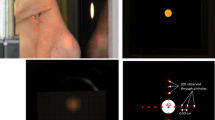Abstract
The human S-cone ERG and single neuron responses from cells mediating the signals of short wavelength sensitive cones (S-cones) were examined and compared with the responses of long (L) and middle (M) wavelength sensitive cones. The S-cone system contributes a relatively small signal to the total cone ERG; it can be selectively light adapted; its b-wave is slower than that of L- and M-cone b-wave; and it lacks a d-wave. Transient tritanopia, a striking feature of S-cone on-retinal ganglion cells, is relatively weak at the level of the ERG. The responses of geniculate neurons were studied using a slowly moving border of energy and wavelength contrast. The ability of cells to respond to wavelength contrast across a border in which energy contrast was reversed was tested in all major varieties of retino-geniculate neurons in the macaque monkey. Cells mediating the signals of S-cones are unique in responding to wavelength rather than energy contrast. The most effective stimulus for such cells is white/yellow wavelength contrast at minimum energy contrast. It is suggested that the S-cone system's major role is to detect wavelength (chromatic) contrast and in particular white and grey from yellow and brown at minimal energy (brightness) contrast.
Similar content being viewed by others
References
Okano T, Kojima D, Fukada Y, Shichida Y, Yoshizawa T. Primary structures of chicken cone visual piments: Vertebrate rhodopsins have evolved out of cone visual pigments. Proc Natl Acad Sci USA 1992; 89: 5932–6.
Willmer EN. Human colour vision and the perception of blue. J Theoret Biol 1961; 2: 141–79.
Stiles WS. Color vision: The approach through increment threshold sensitivity. Proc Natl Acad Sci USA 1959; 45:100–14.
Ladd-Franklin C. Colour and Colour Theories. New York: Harcourt, Brace & Co., 1929.
Gouras P. Identification of cone mechanisms in monkey ganglion cells. J Physiol (London) 1968; 533–47.
Mollon JD, Polden PG. An anomaly in the response of the eye to light of short wavelengths. Phil Trans R Soc 1977; 278:207–40.
Gouras P. Electroretinography: Some basic principles. Invest Ophthalmol Vis Sci 1970; 9: 557–69.
Van Norren DV, Padmos P. Human and macaque blue cones studied with electroretinography. Vision Res. 13: 1241–54.
Gouras P, MacKay CJ, Yamamoto S. The human S-cone electroretinogram and its variation among subjects with and without L and M cone function. Invest Ophthalmol Vis Sci 1993; 34: 2437–42.
Saeki M, Gouras P. Cone ERGs to flash trains: the antagonism of a later flash. Vision Res 1996; 36: 3229–35.
Simonsen SE, Rosenberg T. Reappraisal of a short wavelength sensitive S-cone recording technique in routine clinical electroretinography. Doc Ophthalmol 1997; 91: 323–32.
Evers, HU, Gouras P. Three cone mechanisms in the primate electroretinogram: two with, one without off-center bipolar responses. Vision Res 1986; 26: 245–54.
Valeton JM, Van Norren D. Transient tritanopia at the level of the ERG b-wave. Vision Res 1979; 19: 689–91.
Dacey DM, Lee BB. The blue on-opponent pathway in primate retina originates from a distinct bistratified ganglion cell type. Nature 1994; 36: 731–5.
Malpeli JG, Schiller PH. Lack of blue off-center cells in the visual system of the monkey. Brain Res 1978; 141: 385–9.
Gouras P, Zrenner E. Color vision. A review from a neurophysiological perspective. In Autrum H, Ottoson D, Perl ER. Schmidt RF, eds. Progress in Sensory Physiology. Vol 1. Berlin, Heidelberg, New York: Springer, 1981: 139–79.
DeMonasterio F, Gouras P. Functional properties of ganglion cells of the rhesus monkey retina. J Physiol (London) 1975; 251: 167–95.
Valberg A, Lee BB, Tigwell DA. Neurones with strong inhibitory S-cone inputs in the macaque lateral geniculate nucleus. Vision Res 1986; 26: 1061–4.
Kolb H, Goede P, Roberts S, McDermott R, Gouras P. Uniqueness of the S-cone pedicle in the human retina and consequences for color processing. J Comp Neurol 1997; 443–60.
Schroedinger E. Ueber das Verhaltnis der Vierfarben-zur Dreifarbentheorie. Sitzungsber Math Naturwiss Klasse Kaiserlichen Akad Wiss Wien. 1925; 134: 471-90.
Author information
Authors and Affiliations
Rights and permissions
About this article
Cite this article
Gouras, P. The role of S-cones in human vision. Doc Ophthalmol 106, 5–11 (2003). https://doi.org/10.1023/A:1022415522559
Issue Date:
DOI: https://doi.org/10.1023/A:1022415522559




